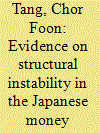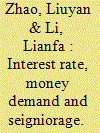| Srl | Item |
| 1 |
ID:
122457


|
|
|
|
|
| Publication |
2013.
|
| Summary/Abstract |
The main purpose of this study is to re-investigate the long-run Japanese M2 money demand function and its stability over the period of 1970:Q1 to 2010:Q4. This study uses the bounds testing approach to cointegration within the autoregressive distributed lag (ARDL) framework to examine the presence of a cointegration relationship. The rolling regression procedure is then incorporated into the ARDL cointegration test to investigate the stability of the cointegrating relationship between money demand and its determinants in Japan. With the full sample, this study confirms that real M2 money demand, real income, real interest rates and real exchange rates are cointegrated. However, the evidence of the rolling ARDL cointegration test implies that the cointegrating relationships are not stable over time, indicating that the Japanese M2 money demand function is also unstable. In line with the rolling ARDL cointegration results, the recursive Chow breakpoint F-test and the Quandt likelihood ratio (QLR) test also suggest the same instability outcome.
|
|
|
|
|
|
|
|
|
|
|
|
|
|
|
|
| 2 |
ID:
143417


|
|
|
|
|
| Summary/Abstract |
The lack of an observable variable measuring inflationary expectation has been a major difficulty in empirical work on hyperinflation. In this paper we propose a direct measure of expectations—the black-market interest rate in Shanghai—and study the behavior of money demand in the Chinese hyperinflation. Although the log–log schedule may provide an accurate description of money demand with relatively low interest rate, the pattern of seigniorage collected in the highest hyperinflation is consistent with the prediction of the semi-log schedule. The comparison of the seigniorage actually collected with the maximum steady state level shows that the economy might be on the increasing side of the Laffer curve except for the concluding stage of the hyperinflation. This suggests that the Chinese hyperinflation has been driven mainly by the government's quest for revenue.
|
|
|
|
|
|
|
|
|
|
|
|
|
|
|
|
| 3 |
ID:
106233


|
|
|
|
|
| Publication |
2011.
|
| Summary/Abstract |
Many studies analyze the money demand using a (fixed coefficient) cointegrating regression model, which may not be appropriate to deal with the money demand of a transition economy like China. This paper investigates this issue using a time-varying cointegration approach based on the quarterly data from 1996 to 2009. We find some interesting results: (i) the estimates of the income elasticities are between 0.60 and 0.75, which are comparable with the previous studies; (ii) the estimated interest rate elasticity supports the argument that the overall effect of the interest rate on the money holding is weak although there are some mild evidences that it has been strengthened in recent years; (iii) the substitution effect of equity asset dominates the wealth effect, especially, during the bullish market period. Our result is robust to the alternative choices of the scale or opportunity cost variables and shows that omission of the stock prices in the money demand function would possibly yield a misspecification problem.
|
|
|
|
|
|
|
|
|
|
|
|
|
|
|
|